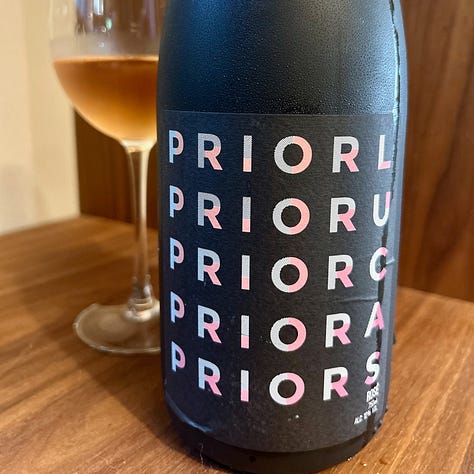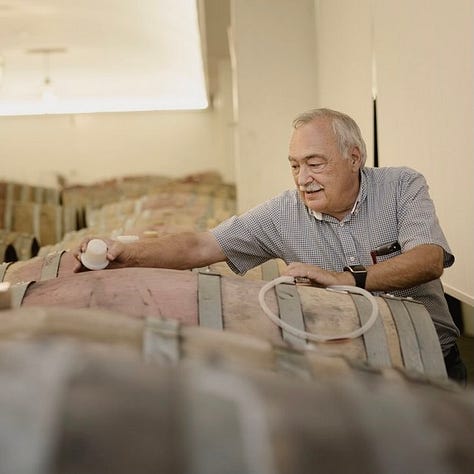Portugal's Red Wines Are No Longer "Up-and-Coming"
Cooler, fresher, lower-alcohol “Atlantic reds” are the sort of wine you should be drinking now.
Let’s have a show of hands: Who knows someone who’s traveled to Portugal over the past few years? I’m guessing there’s a lot of hands in the air, especially among my readers. Lisbon, in particular, has been one of the hottest destinations for American travelers since the pandemic. So much so that, unfortunately, Lisbon has become a poster child for “overtourism” and the Portuguese government is cracking down by banning new Airbnbs, trying to curb cruise ship visits, and denying visas to Americans. So far, that has yet to stanch the flow of tourists to Lisbon.
Given how many people visit Portugal, I find it surprising that Portuguese wines, which I love, haven’t made more headway in the U.S. Well, maybe “surprising” is the wrong word. In the half-decade since I published Godforsaken Grapes, I’m intimately familiar with how wine’s gatekeepers sideline lesser-known wine regions and grape varieties.
Wine gatekeepers love to call places like Portugal “up-and-coming.” They also use that term for wine regions like New York’s Finger Lakes or South Africa or Catalonia—as if to keep them perpetually in second class. But after my latest trip to Portugal (trying my best to avoid the crowds) I can no longer ride along with the idea that Portuguese wines are up-and-coming. They have arrived.
Portuguese red wine still has the lingering perception of big, oaky, high alcohol, and jammy from the Douro Valley or Alentejo—what many in the Iberian peninsula have taken to calling “Mediterranean” reds, as opposed to so-called “Atlantic” reds.
That perception is quickly changing, as Portuguese winemakers embrace the coast and focus more and more on cooler, fresher, lower-alcohol “Atlantic reds.” Whether it’s baga from Bairrada, or castelão and ramisco from the coastal areas surrounding Lisbon, these wines are very different from the Portuguese reds that an American wine drinker likely encountered even 5 or 10 years ago.
But there is still work to do in spreading the word about the new wave of Portuguese wine. “The new generation of Portuguese wineries is still paying the price of the past,” said Luis Gil of Marinho Vinhos, a terrific natural winemaker in coastal Óbidos, about an hour north of Lisbon.
The evolution of wine in Portugal has been similar to many regions. It’s an ancient wine culture with more than 300 native grapes. But at the end of the 20th century, growers were pushed to “modernize,” and made the misguided decision to rip out the native grapes and plant well-known “international” grapes. After several decades trying to make middling, derivative wines from ubiquitous grapes like cabernet sauvignon or merlot, Portuguese winemakers have returned to the unique, indigenous grapes of their grandparents, which better express the terroir.
“After Portugal joined the European Community (in 1986) many people from outside came to ‘modernize’ things. But a lot of times, they just planted the international grapes,” said Filipa Pato, one of Portugal’s most exciting producers. “When I started in 2001, a lot of people were abandoning their vineyards, or else they were planting cabernet sauvignon or merlot. People thought the problem was the native grapes, and they started to replant other grapes.”
Things have changed. As Pato told me, “This is a good moment in Portugal, because people are proud once again of their traditions.”



Baga: Portugal’s Top Red?
When it comes to obscure grapes, a name means a lot. Baga, with four letters and two easily pronounced syllables, make this red wine eminently easy to order in a wine bar. Which—let’s not pretend otherwise—goes a long way toward acceptance.
Acceptance is something that’s taken a while for baga. It’s always been the main red grape of the Bairrada, in north-central Portugal, near the city of Coimbra. But in the past, it had a mixed reputation. I first wrote about the grape a decade ago, right around the time the landmark 1,280-page tome Wine Grapes (by Jancis Robinson, Julia Harding, and José Vouillamoz) was published. In Wine Grapes, the authors call baga “controversial” and say it’s “either loved or loathed” and makes both “the best of wines and the worst of wines.”
I love it. Baga is a finicky, thin-skinned, late-ripening variety with high acidity and serious tannins that can make complex, savory, mineral wines with similarities to nebbiolo, cabernet franc, or syrah. Wines made from Baga feel very much of the moment. “When I started making wine in 2001, people didn’t want baga,” Filipa Pato says. “Nowadays, it’s the fashion.”
Filipa Pato’s father, Luis Pato, was the first to advocate for baga in Bairrada as a world-class grape. “When Luis Pato had the dream to make baga the main grape of the region, people said he was crazy,” said Maria Pato (Luis’ daughter and Filipa’s sister). “Baga was forgotten for decades. People were still drinking it here, but they weren’t talking about it, and they weren’t selling it.” (Note on the Pato family tree: Filipa Pato left her father’s winery to make wine with her husband, William Wouters. Maria Pato also makes her own wine under her Duckman label; Pato means “duck” in Portuguese.)
Bairrada, only about 20 kilometers from the Atlantic coast, has always been known for its sparkling wine, made with baga. In fact, everyday sparkling baga is the classic pairing with the local specialty leitão, or suckling pig roasted on a spit. “Bairrada may be the only place that sells more sparkling wine than beer,” says Maria Pato. But Luis saw an opportunity to make top-flight still red wines from the grape.



Of course, the Pato family are not the only winemakers in Bairrada. “I truly believe baga is one of the most interesting varieties and it can compete with the best varieties in the world,” said Luis Gomes, who makes still and sparkling wines under his Giz label (pronounced jhEEz. “I think I will have to change the name in America,” Gomes said, with a chuckle).
A wave of new winemakers has emerged in Bairrada. Rui Lucas of Prior Lucas, whose first vintage was 2013, is one of them. “I was having a midlife crisis and I decided to start making wine,” Lucas said. He took over his grandfather’s vineyards, along with some others that belonged to older neighbors. “Winegrowers were abandoning their vineyards. I saw an opportunity to preserve our heritage,” he said.
“In the early years, it was hard to sell baga. But over the past seven years it’s changed,” he said. “Now people come to me asking for baga.”
Castelão: Historic Grape With A Fresh Outlook
The first time I went to Portugal was in 1992, when my parents, my brothers, and I drove around the country after I graduated from college. Today, it is hard to envision how profoundly different Portugal was three decades ago. At that time, the only Portuguese wine most Americans knew (beyond Port) was Mateus, the sweet fizzy rosé in the goofy flask-shaped bottle. Mateus (incidentally, Saddam Hussein’s favorite wine) accounted for almost half of the table wine exported from Portugal in the late 1980s.
One night, my family stopped in the port of town called Setúbal, on the peninsula south of Lisbon and ate dinner at some random, traditional restaurant on a side street. In 1992, we may have been the first American family of five to have ever set foot in this restaurant.
At first, the server was gruff, especially as we pantomimed in bad Portuguese. The unsmiling owner brought over a carafe of astringent and nearly undrinkable red wine that smelled like a wet dog. With great contempt, he asked, “You are British?”
“No, no,” we told him, “We’re Americans.” Suddenly, something quite amazing happened. The owner’s face brightened into a big smile, and he called his wife and son over. “They’re Americans,” he said, seemingly relieved we were not part of the hordes of boozy, sunburned Brits who overrun Portugal in the summer. The whole mood swiftly changed. Complimentary plates of meats and cheeses came out. The owner whisked away the carafe of cheap plonk, and his son brought over a bottle from the cellar and uncorked it for us. It was wonderful: dry, tannic, smoky, dark, rustic. For us, it was the taste of old Europe in the glass. I believe when the bill came it was less than $4 a bottle.
What the owner had opened and poured for us was Periquita, Setúbal’s most famous wine, and historically Portugal’s first bottled red wine. Periquita, 30 years later, is now imported by giant Palm Bay International, and is one of the most widely available Portuguese wines that you can find in the U.S.—it still only costs around $12. For me, Periquita’s quality has dipped over the years (or my palate is more sophisticated than it was at 21) but that bottle will always have a soft spot in my heart.
Periquita has always been predominantly made with castelão, a native variety that’s widely planted in Portugal, particularly around the coast near Lisbon. So this has always been my association with castelão.
But these days, there’s been an incredible quality revolution with castelão wines. I’ve been tasting a bunch of castelão wines this summer, and I’m hooked. They’re fresher, cooler, less oaky. They range from perfectly drinkable, zippy glou-glou wines to more complex, mineral- and acid-driven reds that pair so well with all kinds of food.
As with baga, the coastal castelão wines, from producers such as Marinho Vinhos, Baías e Enseadas, Hugo Mendes, and Adega Viúva Gomes, feel very of the moment.
Ramisco: A True Unicorn Wine
Wines made from ramisco grapes are the most idiosyncratic and hard-to-find of the three. True unicorn wines, in fact. Ramisco is particularly tannic and acidic, and requires long aging. It’s only produced in Colares, an area near Lisbon consisting of a precious few dozen vineyard acres perched on cliffs above the Atlantic Ocean, near the castle of Sintra.
Colares is one of the world’s oldest wine regions (once known as “the Bordeaux of Portugal”) boasting some of the few remaining pre-phylloxera vines in Europe. These vineyards are in danger of being snatched up by real estate developers eager to build beach homes, which means Colares could, some day, cease to exist as a wine region.
So, basically, Colares represents everything a modern wine geek seeks out and loves: an obscure grape; an endangered region; in-your-face tannins and acidity; a wine that will age forever; and a wine that’s almost extinct.
Currently, Adega Viúva Gomes makes the only bottlings of ramisco that you’ll likely find in the U.S. And even then, there are only four vintages: 1965, 1967, 1969, 2015. I can tell you from my own tastings that the 2015 is amazing, and the 1969 is transcendent. I am still looking for the 1965 and 1967. Good luck, unicorn hunters!
This piece first appeared in The New Wine Review, which is now owned by Unicorn Auctions.
New-Wave Portuguese Reds
My 15 bottles picks below, with tasting notes, are for paid subscribers only. Upgrade now so you don’t miss my weekly recommendations. Right now, I’m offering a discount!





